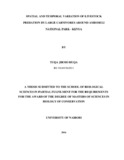| dc.contributor.author | Tuqa, Jirmo H | |
| dc.date.accessioned | 2016-11-22T10:26:33Z | |
| dc.date.available | 2016-11-22T10:26:33Z | |
| dc.date.issued | 2016 | |
| dc.identifier.uri | http://hdl.handle.net/11295/97696 | |
| dc.description.abstract | Most large mammalian carnivores are in global decline, partly due to their involvement in livestock predation. Research that advances our understanding of predator livestock interaction is crucial to conflict mitigation and carnivore conservation and management. The study investigated the influence of environmental and socio-ecological factors on livestock predation by large carnivores in pastoral villages adjacent to the Amboseli National Park in Kenya during a 13-month period (July 2012 – July 2013). A number of factors were identified related to temporal and spatial variation that influences livestock predation rates. Aassessment on how environmental changes affected the distribution and dynamics of vegetation and animal populations. The overall purpose of this study was to determine the intensity of livestock predation by large carnivores in space and time around Amboseli National Park. In the study we investigated livestock predation by large carnivores and factors predisposing in Olgulului and Kimana community group ranches in the southern Kenya during the period between July 2012 and July 2013. In addition if livestock predation rate and intensity varied with season, boma (livestock shed) density and the carnivore species as well. Large carnivore - livestock predation incidences were mapped and a total of 26 herbivore transect counts were conducted in and outside the park during both dry and wet season. The result revealed that there were more prey (herbivores) density inside the park during the dry season as compared with wet season. There was negative correlation between vegetation density, boma density and livestock predation incidences. A total of 1409 predation incidences recorded during the 13 months periods which were attributed to specific predators. Hyenas killed more livestock followed by Jackals, Cheetah and lions respectively. There were a positive correlation (r = 0.766, p = 0.131, n=5) indicating that some carnivores especially hyenas preferred to keep a certain distance from human settlements. More animals were killed while on the grazing fields and lions killed more livestock inside Boma. Conflict was most frequent during evening, late night and mid-morning. The predations by carnivore species were spatially clustered. This conforms to the assumption of non-homogenous distribution of natural resources needed by the animals. Some environmental variables such as human settlement and density of wild prey greatly influenced the observed pattern of carnivore attack distribution. | en_US |
| dc.language.iso | en | en_US |
| dc.publisher | University of Nairobi | en_US |
| dc.rights | Attribution-NonCommercial-NoDerivs 3.0 United States | * |
| dc.rights.uri | http://creativecommons.org/licenses/by-nc-nd/3.0/us/ | * |
| dc.subject | Spatial and Temporal Variation of Livestock | en_US |
| dc.title | Spatial and Temporal Variation of Livestock Predation by Large Carnivores Around Amboseli National Park - Kenya | en_US |
| dc.type | Thesis | en_US |



